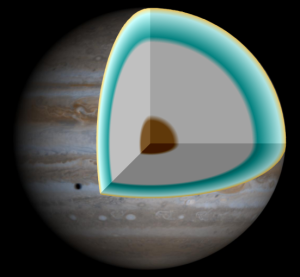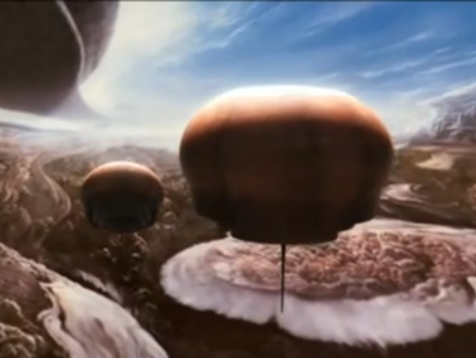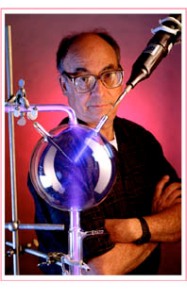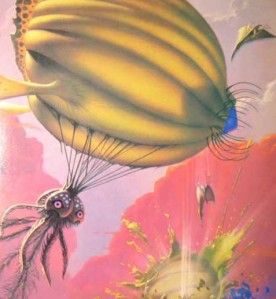In a previous post I talked about the possibility of life existing on, or in, some of the moons of Jupiter, with Europa being the best candidate.
But how about life existing within Jupiter itself?
A common misconception about Jupiter is that it’s entirely made of gas. I remember being told in school that you could drive a bus right through it (some kind of space bus I guess), as it wasn’t solid like terrestrial planets such as Earth or Mars. But this isn’t quite true. Jupiter most likely has a solid heart, officially called a kernel, made of rock and ice. This kernel may be differentiated into a central metallic core, a rocky inner mantle, and an outer mantle of ice, a bit like some of Jupiter’s moons such as Europa, and may be as much as 45 times more massive than Earth.
As Jupiter formed, this kernel captured vast amounts of hydrogen and some helium gas as it orbited the Sun, which formed the outer layers of the planet and make up most of its mass and volume today. However, as Jupiter is so massive, much of this hydrogen is compressed under great pressure and exists as a metal-like liquid; essentially a thick layer of liquid hydrogen nuclei swimming in a sea of free electrons. You probably wouldn’t want to drive a bus through that; it’d be like jumping into a high-pressure ocean of electrically charged liquid metal.
 A representation of Jupiter’s interior, with a central kernel of ice and rock, a thick layer of metallic hydrogen, and an outer layer of gaseous hydrogen with some helium and other trace gasses
A representation of Jupiter’s interior, with a central kernel of ice and rock, a thick layer of metallic hydrogen, and an outer layer of gaseous hydrogen with some helium and other trace gasses
OK, all that may be interesting (hopefully), but Jupiter certainly doesn’t sound like the kind of place that life could thrive; there aren’t any predicted subterranean oceans like on Europa, Jupiter doesn’t have a rocky surface like Earth, and the metallic hydrogen layer sounds pretty lethal. You can probably see where this is going can’t you? It’s the only place left, Jupiter’s atmosphere (OK, you may have been considering Jupiter’s rings too, but that’s crazy talk).
Towards Jupiter’s outer surface, as the self-compaction pressure falls, the hydrogen and helium transitions from a liquid state to a gaseous state and creates a thick atmosphere around the planet up to 5,000 km deep. This layer is mostly composed of hydrogen gas, but also features some more exotic elements including ammonia, methane and water; the very gasses used in a famous experiment that demonstrated how some of the most important building blocks of life could be created by gasses reacting in a planet’s atmosphere.
In 1952 a PhD student called Stanley Miller, supervised by the chemist Harold Urey, conducted an experiment where he passed water vapour through a flask containing methane, ammonia and hydrogen gas, and subjected it to a periodic electric charge. As the water passed through the gas it was collected and cooled in another flask, and after one week of continuously running the experiment Miller analysed the contents of this flask and found to contain a number of organic molecules, including sugars, fatty acids and all of the twenty common amino acids used to build life on Earth.
This was a huge moment in science, probably the most famous laboratory investigation into the origin of life, a key moment in the history of astrobiology, and must have made for one hell of PhD thesis! Miller hadn’t created life in the laboratory, but he had shown that important organic molecules could be synthesised from simple and common gasses in an atmosphere charged by lightening. Apparently Miller was trying to replicate the atmosphere of the early Earth when he conducted this experiment (although he may have got this wrong), but the experiment has implications for other planets, including Jupiter, which has an upper atmosphere reasonably similar in composition to Miller’s experiment (but with different abundances).
On the face of it, Jupiter’s atmosphere has all of the key requirements for life; water, the elements required to build organisms, and a heat source, as Jupiter generates huge amounts of heat due to its continued self-compression. This has led a number of scientists and writers to hypothesise that life could have emerged in Jupiter’s upper atmosphere and evolved into bizarre floating and swimming life forms, including the notion that Jupiter could have an ecosystem composed of simple planktonic life drifting in its upper atmospheric layers, fed on by floating jelly-fish like organisms, which in turn could be fed on by deeper, faster moving fish-like hunting creatures.
So how likely is this exotic floating alien ecosystem?
Sadly, pretty unlikely. Firstly, although Jupiter’s atmosphere contains some water, it probably doesn’t have much, and what water it does have probably exists deep within Jupiter’s atmosphere, likely at a depth that would be lethal to life.
Secondly, Jupiter’s atmosphere is far from tranquil. If you look at a picture of Jupiter you see horizontal bands of colours, these are clouds of gas, mostly ammonia, flowing horizontally in Jupiter’s atmosphere at different speeds. The lighter ones, usually a white colour, are called zones, and are regions of Jupiter’s atmosphere that are rising, while the darker clouds, usually orange to red are called belts and are areas in Jupiter’s atmosphere that are descending. Life living in Jupiter’s atmosphere would likely be at the mercy of these vertical atmospheric flows, and organisms would probably find themselves being pulled down to depths with a temperature and pressure that would destroy organic molecules.
Jupiter also has powerful horizontal flows between its bands and belts called jets, which achieve speeds up to 100 meters per second (360 km per hour). As these flows interact with neighbouring jets huge vortices can form (like cyclones on Earth), the largest of which is called the Great Red Spot, which has been known to exist continuously for almost 350 years and is so large it could swallow two to three Earths. If life could avoid the deadly vertical currents, I’m pretty sure the horizontal jets would be equally as hazardous.
Carl Sagan has dealt with many of the ideas I’ve mentioned above in his documentary series Cosmos. Here’s a clip below that explains his ideas about life on Jupiter much more clearly than I have, and even provides some potential solutions to the problem of strong vertical currents.
I’d love for Jupiter to be inhabited by a crazy ecosystem of floating organisms, like the one described by Carl Sagan, as the more places scientists find life, and the more exotic the locations, the more likely it will be that our galaxy will be teaming with alien life.
In fact, it would be great news if we found life on Jupiter, as we know that Jupiter-type planets exist around other stars, as these have been the commonest form of exoplanet found to date. But sadly, I don’t think Jupiter will be a good candidate, I think gas giants with such vigorous atmospheres will be too energetic for life to get started or to survive… but I’d love to be proved wrong.
In the next Life in our Solar System post I’ll be looking even further afield, next stop Saturn.





Aucun commentaire:
Enregistrer un commentaire